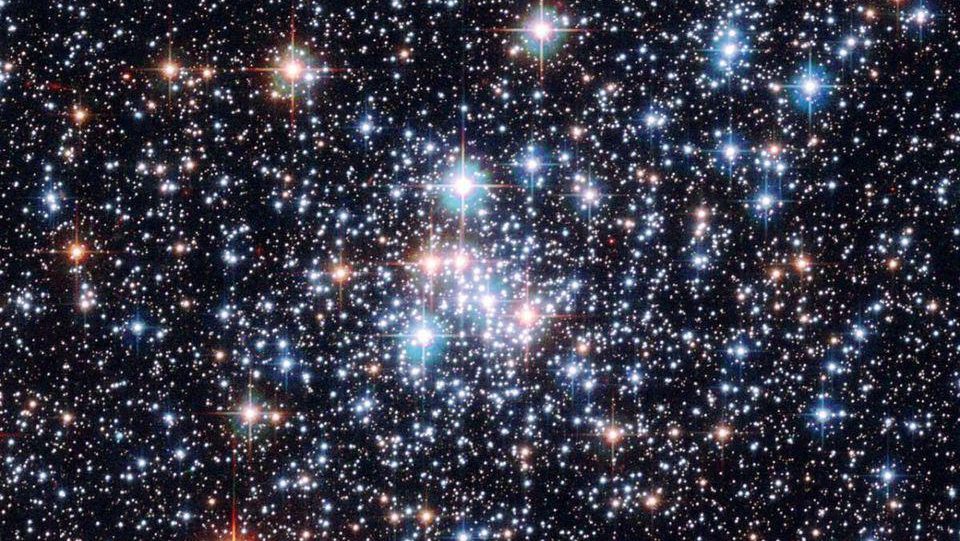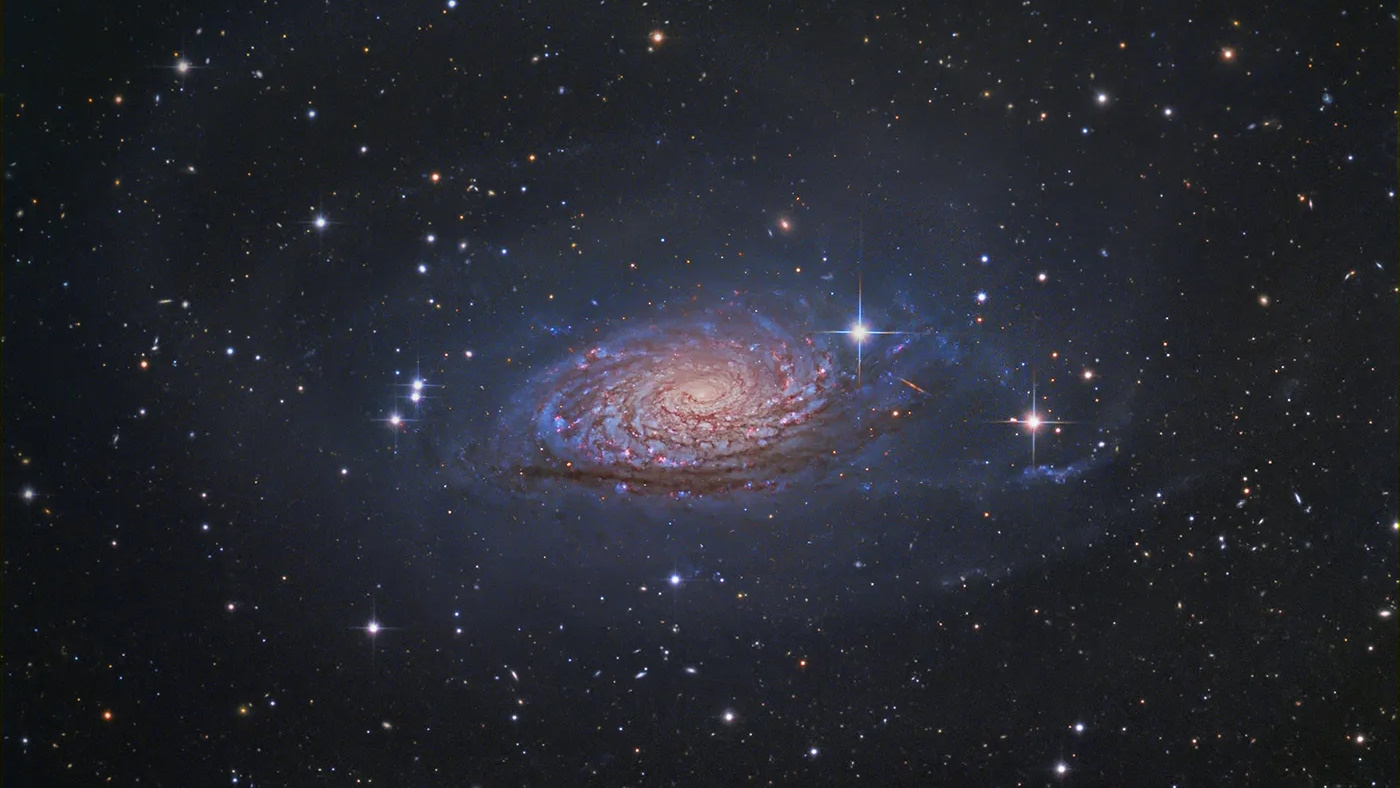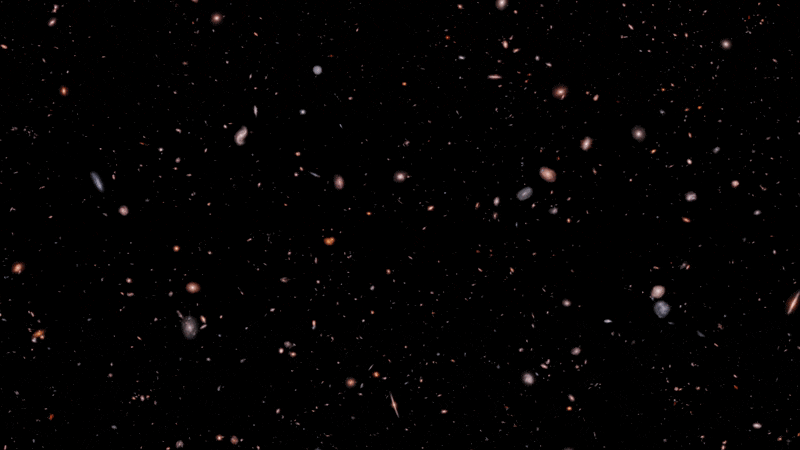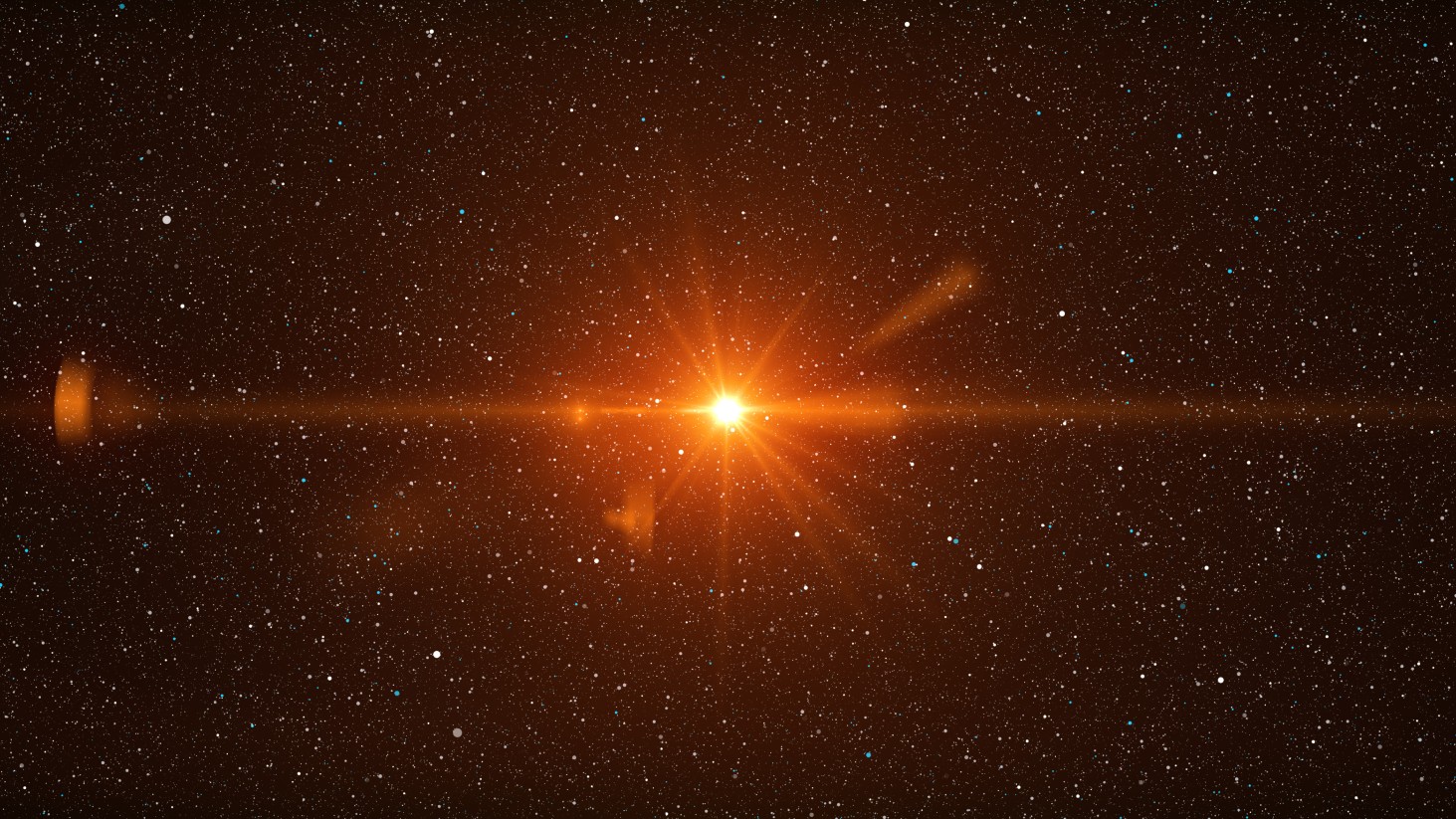Why JWST doesn’t have the same limits as Hubble
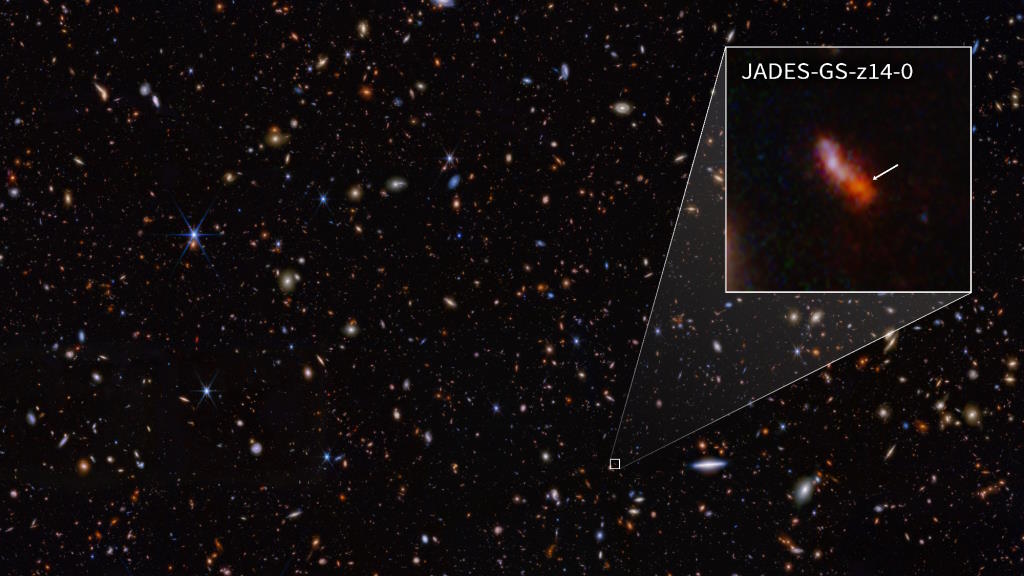
- All astrophysical objects in the Universe emit and/or absorb light, and we can detect them if we’re sensitive enough to the type of light that travels across the Universe and arrives at our instruments.
- Telescopes collect photons from wherever we look in the Universe, but are limited, fundamentally, by a variety of properties: such as the telescope’s temperature and the wavelength of the arriving light.
- JWST now owns all 10 of the top spots for “most distant object” ever discovered, surpassing the limitations of Hubble. So where are JWST’s limits, and why are they so much farther than Hubble’s?
So, you want to find the most distant objects that are out there in the Universe? So do astronomers and astrophysicists of all varieties. Only by looking to greater and greater distances — corresponding to epochs in the Universe that are closer back in time to the hot Big Bang — can we hope to uncover the observational evidence for how our Universe grew up: how galaxies formed, assembled, and gave rise to what we observe nearby, here in our modern Universe. Traditionally, the way we do this is to build large telescopes, gather large amounts of light, and then analyze that light by breaking it up into its different wavelengths to determine just how far away it truly is within the expanding Universe.
Today, our most distant object known is the galaxy JADES-GS-z14-0, which was discovered and measured in a deep-field view of the distant Universe, using the JWST’s NIRCam and NIRSpec instruments. It has a remarkable set of properties:
- it comes to us from when the Universe was just 285-290 million years old, or just 2.1% of its present age,
- it’s bright, as in four to five times brighter than all the other bright galaxies found from the Universe’s first ~400 million years (so far),
- it’s relatively large already, spanning an estimated spatial extent of around 1700 light-years,
- and it’s presently a whopping 33.8 billion light-years away, the most distant individual object ever discovered.
As of mid-2024, all ten of the top ten most distant objects were discovered and measured with JWST, surpassing Hubble’s old limits by large amounts. Yet JWST still has limits of its own, and while it may yet discover more distant galaxies than these, the earliest stars and galaxies of all will forever remain invisible to its eyes. Here’s the science of why.

The way we find and confirm the presence of distant galaxies is actually very straightforward, at least, astrophysically. You simply follow these steps.
- You gather light, as much as you can, from a specific region of space for as long as you can collect it.
- You gather that light across a wide-field of view in several different filters, photometrically at first, to identify ultra-distant galaxy candidates based on where the light does and doesn’t appear.
- Then you observe the most promising ultra-distant candidates spectroscopically, where you break the light from this object into its individual wavelengths at high-resolution, to determine precisely how “redshifted” the light from it truly is.
- And finally, based on the collected data, an inferred gravitational lensing map, and the known properties of our Universe, you determine the properties of this galaxy: its age, its brightness, its distance, and size, for example.
Although this sounds simple, the reality is that the light you can gather — both in terms of the amount of light and also in terms of the properties (i.e., wavelength) of that light — is fundamentally limited by the properties of your telescope or observatory. When we look at the Hubble Space Telescope and the JWST side-by-side, we can immediately see three major differences.
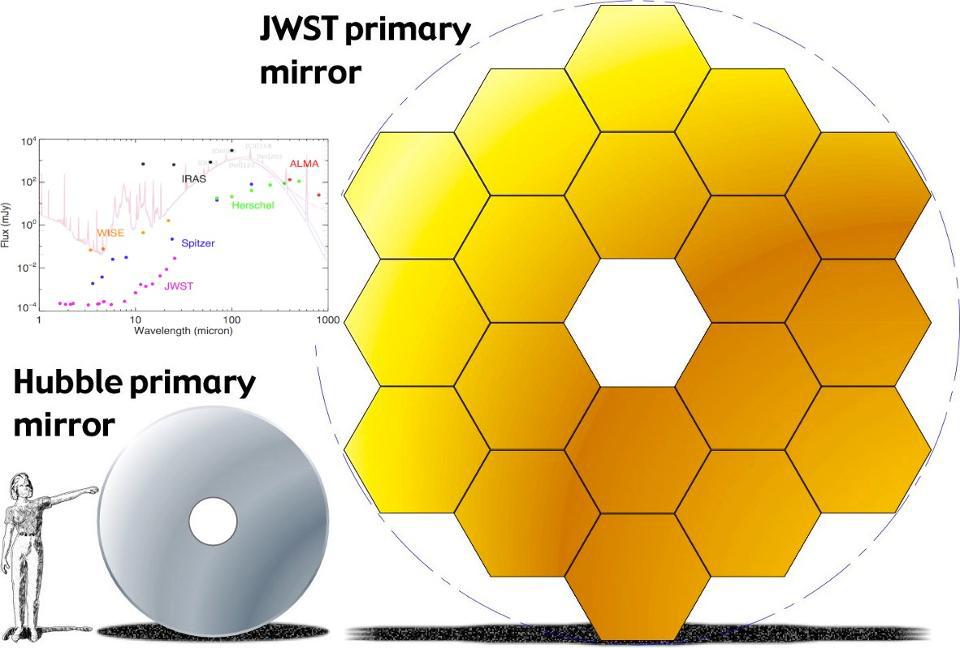
These differences are size, as in the size of the primary (light-gathering) mirror, color, as in the color-coating applied to the mirrors and optical systems that make up the observatory, and temperature, which isn’t so easy to see, but is an integral part of the telescope’s design and construction.
For Hubble, we have a 2.4-meter diameter primary mirror, a reflective coating that appears silvery-clear in color and is optimized for reflecting optical light, and the entire observatory is coated in a highly-reflective coating to reflect both ultraviolet/visible light and infrared (heat) light away from it, which arise from both the Sun (which shines on it about half of the time) as well as the Earth (which radiates heat from just 500-600 km away).
For JWST, however, we have a 6.5-meter diameter primary mirror, a reflective coating that’s gold in color, which is optimized for reflecting both near-infrared and mid-infrared light, while the observatory itself is located very far (1.5 million km) from Earth and is always shielded from the Sun through a novel, passive cooling technology known as a sunshade. In addition, the mid-infrared instrument (MIRI) aboard JWST is outfitted with an additional custom cryocooler, which actively cools that particular instrument down to just 6-to-7 K, making it the coldest part of JWST.
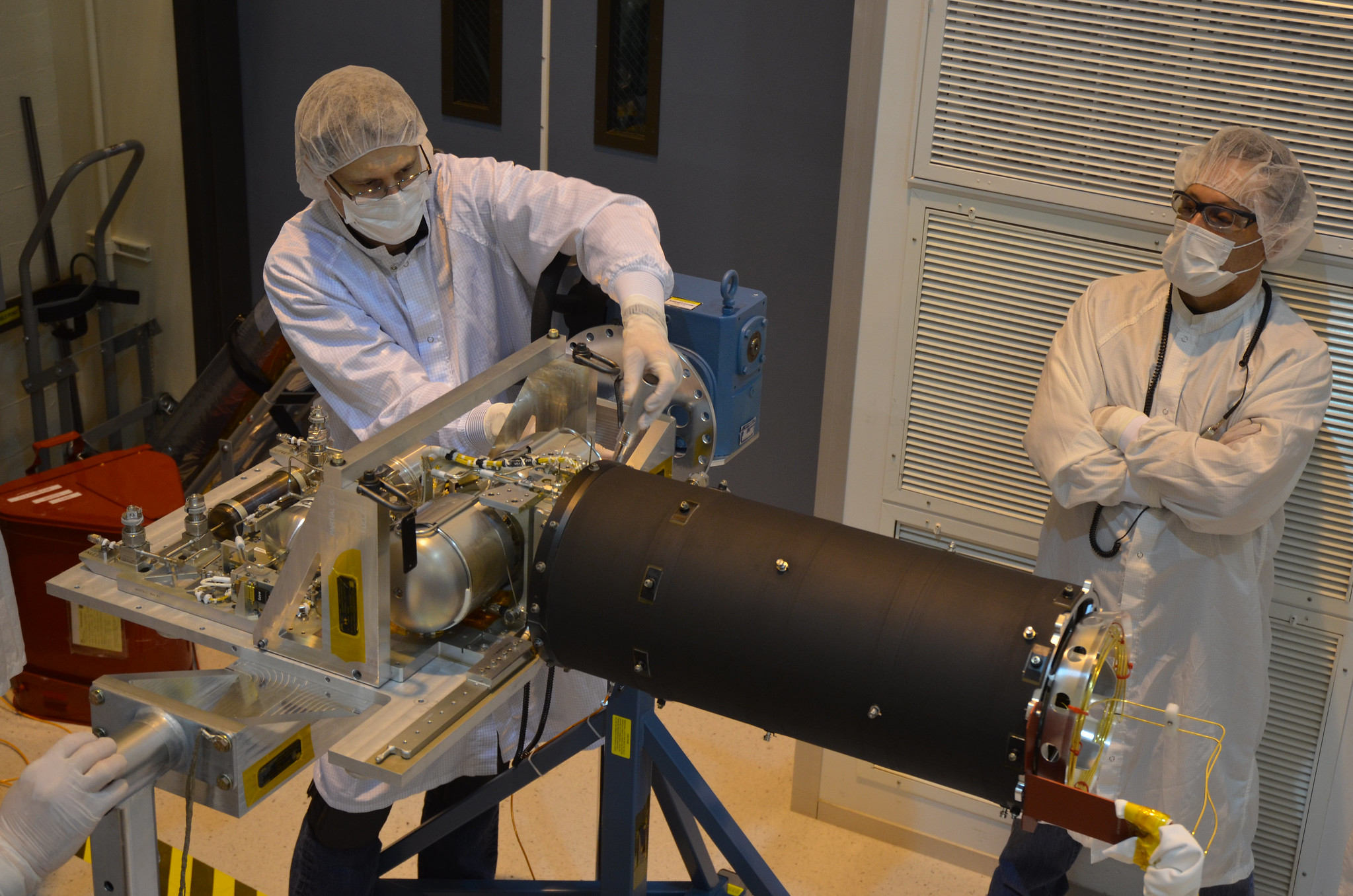
These differences translate into an incredibly different set of parameters, as far as sensitivity goes, for these two observatories. For Hubble, it has a maximum resolution, at 814nm (one of its current main filters, a big upgrade over the old WFPC2 camera’s filter at the same wavelengths, at the interface between visible and near-infrared light), of 0.07 arc-seconds. It experiences periods of extreme hot (in direct sunlight) and cold (in Earth’s shadow), but thermal blanketing and internal heaters keep temperatures stable at around 70 °F (21 °C), keeping the Focal Plane Structure in a stable shape, while small actuators can change the shape of the mirror, slightly, to compensate for variations. This allows Hubble to view the Universe in wavelengths out to between 1.6 and 2.5 microns, but no longer, as otherwise the thermal noise will swamp the light gathered from distant objects.
Meanwhile, at the same wavelength (814 nm), JWST can achieve resolutions of just 0.026 arc-seconds: about three times better than Hubble’s. Its sunshield passively cools the optics and internal instruments down to about ~40 K (-388 °F/-233 °C), allowing observations out to a maximum wavelength of 5 microns (in near-infrared) and all the way out to 28 microns (in mid-infrared), so long as MIRI is cooled down further: to 6-or-7 K. The larger mirror imparts another huge advantage to JWST in addition to wavelength coverage and resolution: superior light-gathering power. JWST can gather as much light with just 1 day of observing time as Hubble can gather in two weeks: a factor of seven coming from the size of the mirror and another factor of two from the fact that Hubble spends 50% of its time having its view of any part of the sky blocked by the Earth.
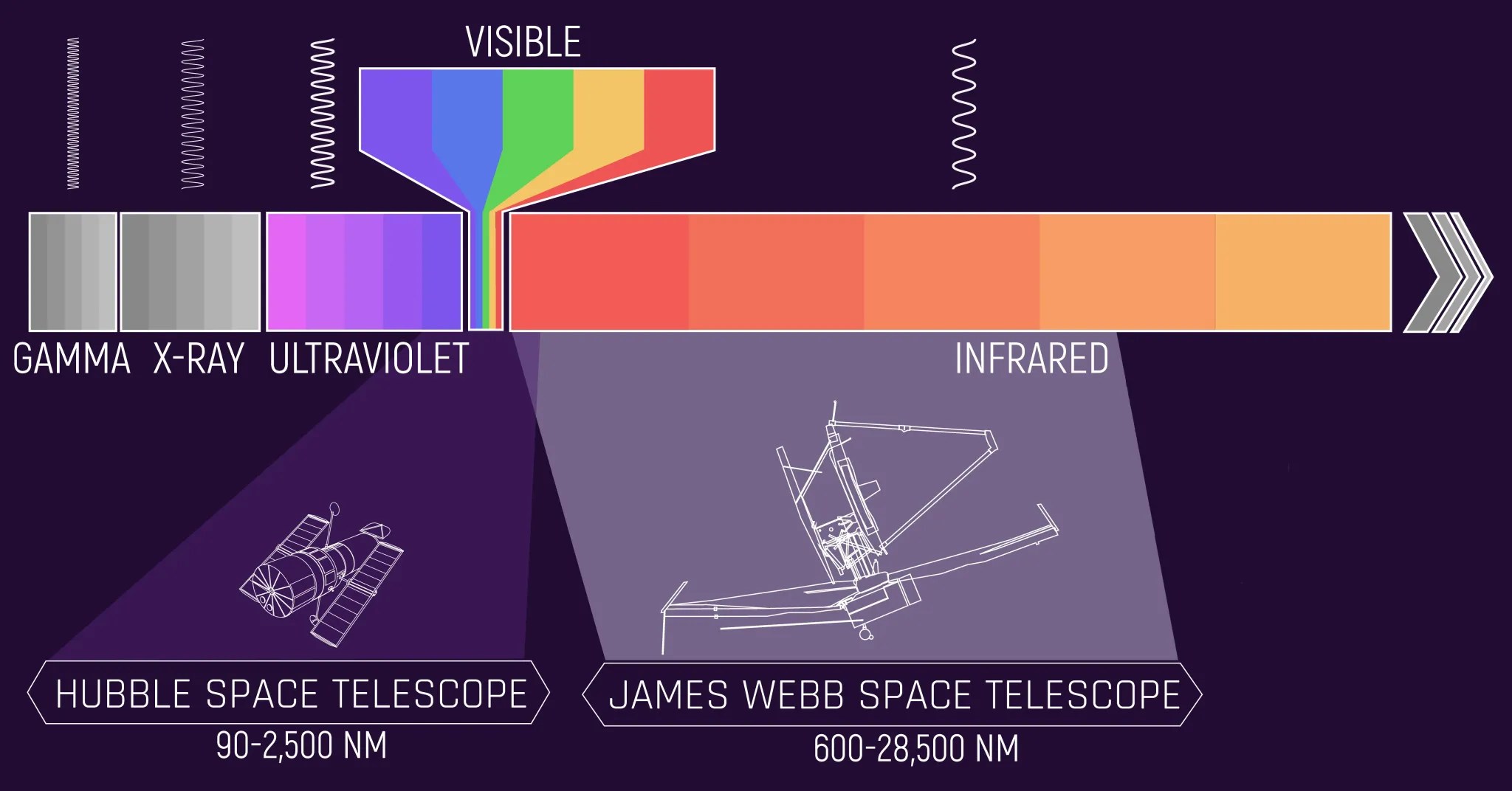
That extra-cold temperature — and especially the fact that the mirrors (i.e., the optics of the telescope) are so cold — is what gives JWST its most important advantage over Hubble: the ability to probe, collect, measure, and manipulate light at much longer wavelengths. The reason is as follows. We normally think of solid objects as, well, solid, and assume that their shape doesn’t change over time. But even solids, like mirrors, still experience what are known as thermal fluctuations: where the atoms, molecules, and even the individual electrons that are all part of that mirror are excited by the (heat) energy that being held at a positive, non-zero temperature imparts to them.
What happens, then, when light comes in and hits those mirrors?
This is the key thing to understand. If the thermal fluctuations are small compared to the energy in each photon, the light that makes it to the instruments will largely, with only a small amount of noise, be representative of the light that was collected from the distant Universe. But if the thermal fluctuations are large (or comparable to) the energy in each photon, the light that makes it to the instruments will be very noisy, as the “signal” from distant objects will be swamped by the noise from these thermal fluctuations. This is the limiting factor for Hubble, and the reason why it’s an ineffective, inefficient observatory beyond about 2 microns in wavelength. JWST, however, remains efficient all the way deep into the mid-infrared, at around ~28 microns in wavelength.

This is incredibly consequential for the Universe, and for our ability to measure and understand it. Atoms and molecules, no matter where they are in the Universe, are made of identical particles: protons, neutrons, and electrons. Every proton in the Universe is identical to every other proton; you could “swap” any two of them and no one would be able to measure or detect a difference. (The same is true for neutrons and electrons.) When you have a neutral atom of a particular species — i.e., with a certain number of protons and neutrons in its nucleus and with a number of electrons that balances the electric charge from the protons — it always exhibits the same spectrum: a series of emission and/or absorption lines at a specific set of wavelengths that are particular to the species of atom in question. (This applies to molecules as well.)
When you look out at a very distant object in the Universe, however, you’re not going to observe those same spectral signatures from the atoms that existed back then, even though they really are identical to the atoms we’re familiar with today. As light travels through the expanding Universe — and space is expanding in between the various bound structures (galaxy, galaxy groups, galaxy clusters, etc.) populating the Universe — the wavelength of that light stretches along with the expansion of space. By the time it arrives at our instruments, it’s already at a much longer wavelength than when it was emitted, with more and more distant objects experiencing ever greater amounts of cosmic expansion, which shows up as a redshift in the light from those objects.
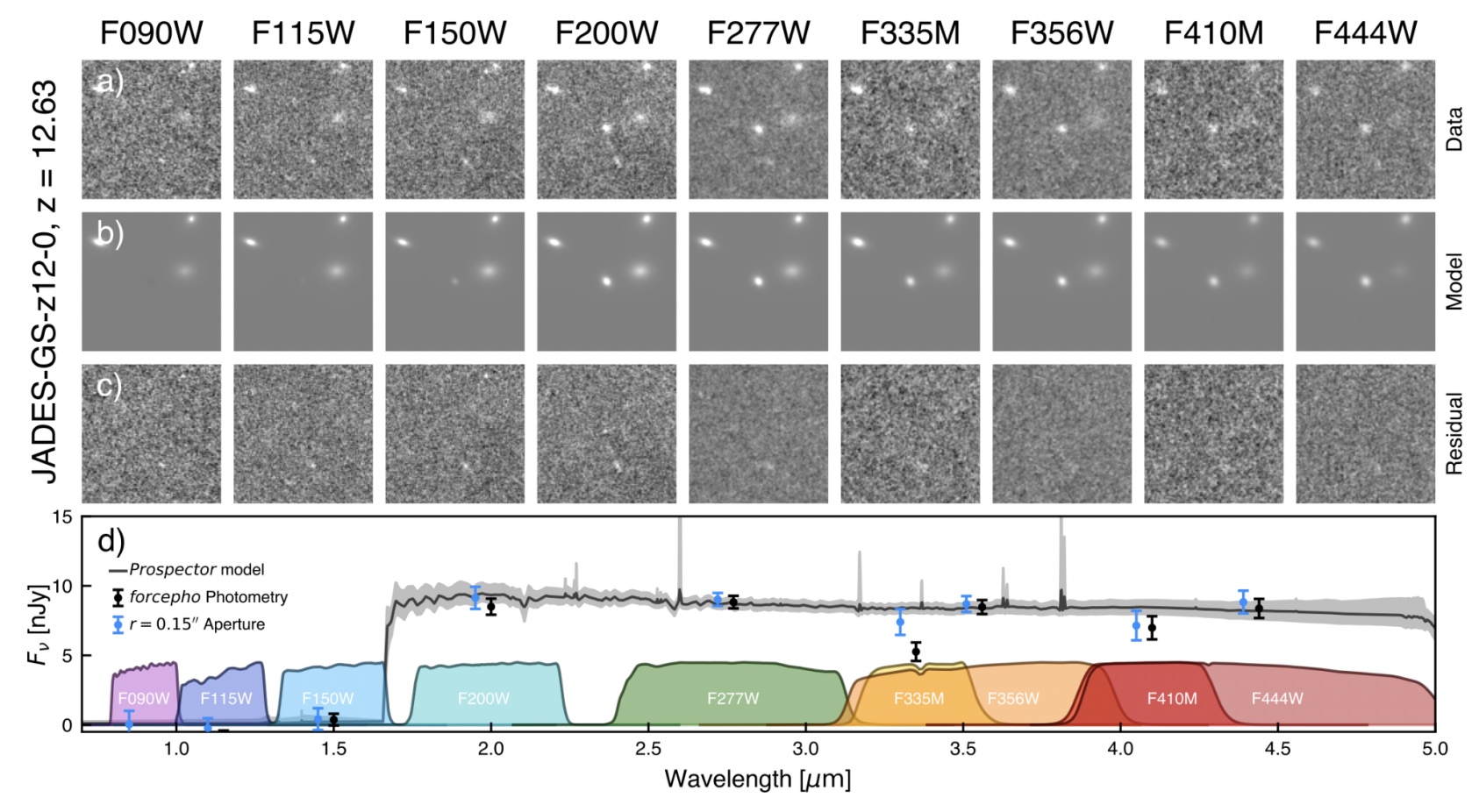
This means something remarkable for distant galaxies. When we perform photometry, which is the “deep exposure” technique we most commonly leverage in regions of the sky like the Hubble Ultra Deep Field (HUDF) or the JWST Advanced Deep Extragalactic Survey (JADES), what we’re doing is the following.
- We probe the same area of the sky for long periods of time, with a specific photometric filter atop the telescope, letting light in only from a specific range of wavelengths.
- We do this for several different photometric filters: at short wavelengths, intermediate wavelengths, and long wavelengths.
- We pay particular attention to objects that are invisible at short wavelengths, but that only appear — and appear brightly — past some relatively long wavelength threshold.
It’s those objects, that don’t appear at short wavelengths but that do appear at longer wavelengths, that make the best candidates for high-redshift, ultra-distant galaxies. All galaxies contain large amounts of hydrogen, and when stars within those galaxies shine, they emit lots of ultraviolet, visible, and infrared light. However, the Universe is filled with neutral atoms: light-blocking material, such as hydrogen. As the emitted starlight travels through the Universe and encounters clouds of neutral (mostly hydrogen) atoms, the shorter-wavelength light gets absorbed, leaving only the longer wavelengths remaining. That’s the explanation for why observing these galaxies photometrically, and selecting the ones invisible at short wavelengths but that appear bright at long wavelengths, make for such good ultra-distant galaxy candidates.
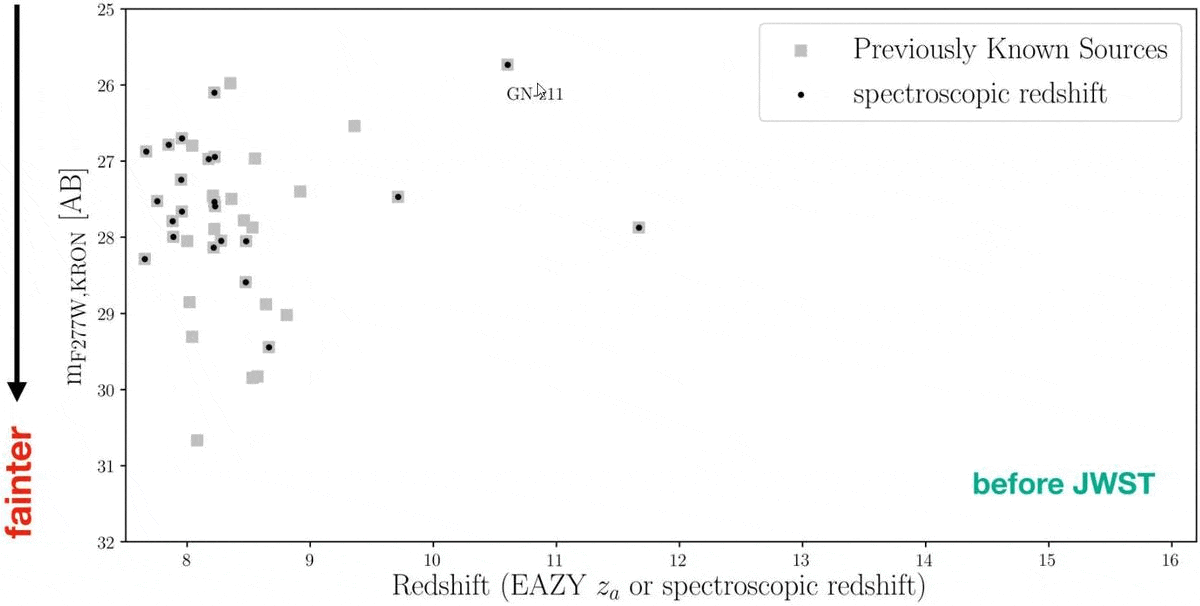
But there’s a big difference between a galaxy candidate and a confirmed galaxy, and the difference is spectroscopic data. By taking long-exposure data of an ultra-distant galaxy candidate spectroscopically, we can collect light and break it up into its individual wavelengths. Unlike photometry, which sums up all the light within a given wavelength range and gives you the cumulative amount, spectroscopy has very fine energy resolution, and can reveal many absorption and/or emission features. While an ideal spectrum will display many lines that correspond to various elements, all that we truly need is one major feature to identify the redshift (and hence, the distance to) a galaxy: the Lyman break.
When hydrogen atoms get excited (or ionized and then re-form), their electrons get bumped up to very high energy levels: out of the ground state. They then spontaneously de-excite down to the ground state, emitting a high-energy, Lyman-series photon. The original, luminous galaxy emits many Lyman-series photons, but the intervening gas-and-dust blocks all the light at shorter wavelengths: absorbing that light. This leaves only a trough at short wavelengths, where all of the light gets absorbed before reaching our eyes, followed by a bright peak that corresponds to the unblocked (or less blocked) Lyman-alpha line, which appears at precisely 121.5 nanometers in the rest (laboratory) frame. By measuring this Lyman-alpha feature, known as the Lyman break, we can then measure how much the Lyman-alpha feature has had its wavelength “stretched” by, and therefore, we can know what its redshift and distance are.
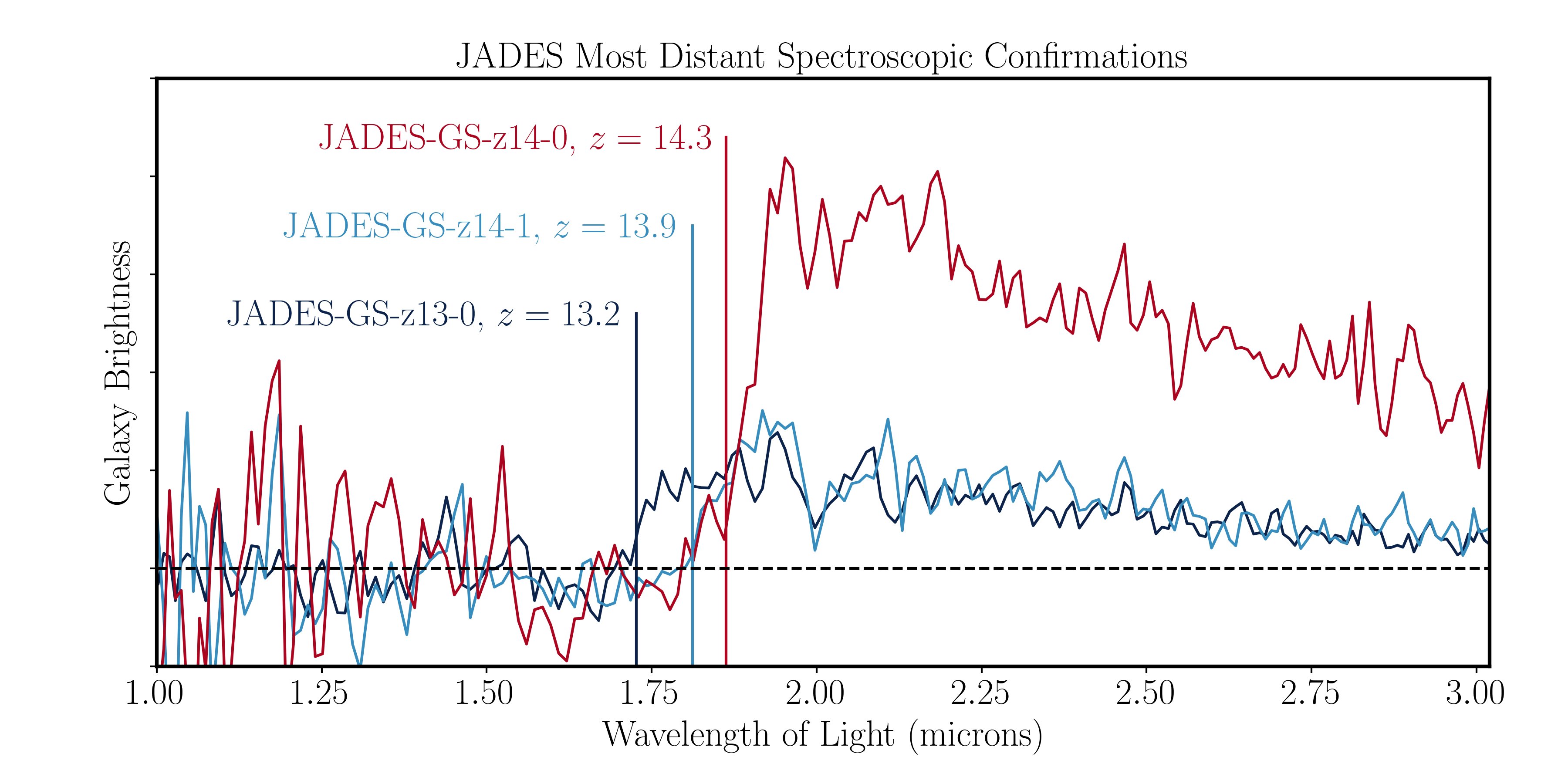
For Hubble, the highest redshift object it ever detected was galaxy GN-z11, which has a redshift of 10.6. To find out what this means for a Lyman break, simply multiply that 121.5 nanometers by (1 + redshift), which works out to 11.6 in that case, yielding a feature that appears at approximately 1400 nanometers (1.4 microns). This is impressive, to be sure, as it indicates that light that was emitted in the ultraviolet has been stretched out of the ultraviolet, into and then out of the visible part of the spectrum, and all the way into the infrared. But because of thermal noise and its relatively small amounts of light-gathering power, Hubble was unable to spot any galaxies more distant than this.
But JWST can go much farther. Its current record-holder, JADES-GS-z14-0, is at a redshift of 14.32, which means the Lyman break feature appears at 1860 nanometers (1.86 microns), and that doesn’t even come close to JWST’s wavelength limits. It can do:
- NIRCam photometry out past 4 microns,
- MIRI photometry (albeit at lower resolution) out past 20 microns,
- and spectroscopy, with NIRSpec or MIRI, over that entire wavelength range.
Even if we assume the NIRCam photometric limit, we should be able to — if we collect sufficient amounts of light for sufficiently long time periods — see galaxies all the way out to a redshift of ~40, or a distance of ~39 billion light years, and a time when the Universe was just ~64 million years old.

And yet, for three very good reasons, even this may not be enough. First off, the very earliest stars may have formed even earlier than this; some estimates place them just 30 million years after the Big Bang, at a redshift of ~65. Second, there’s a tremendous amount of light-blocking matter the earlier and earlier we look, and at some point, it may prevent that initially ultraviolet light from propagating to our telescopes, obscuring JWST’s views entirely. And third, there’s a limit to how much light, of any-and-all types, that JWST will ever practically gather. It has a fixed size, it has many different observations to make, and it has a wide variety of observing strategies to choose from. Galaxies beyond a redshift of ~20 or so may forever be invisible to it, at least in any practical, realistic sense.
And yet, there are other prospects. Early starlight will excite and ionize hydrogen atoms in the interstellar/intergalactic medium. Even if the light is absorbed completely, those atoms will still become ionized, and then neutral again. When hydrogen nuclei and electrons recombine, half of them will have their spins (randomly) aligned, and as their spins flip, they emit radiation which won’t be absorbed, but will propagate all the way to our eyes, albeit at radio frequencies. It may take a giant radio telescope on the Moon’s far side to detect this evidence, but if our goal is to truly find the very first stars and galaxies of all, it might take this advance, past the limits of JWST, in order to take us there.
